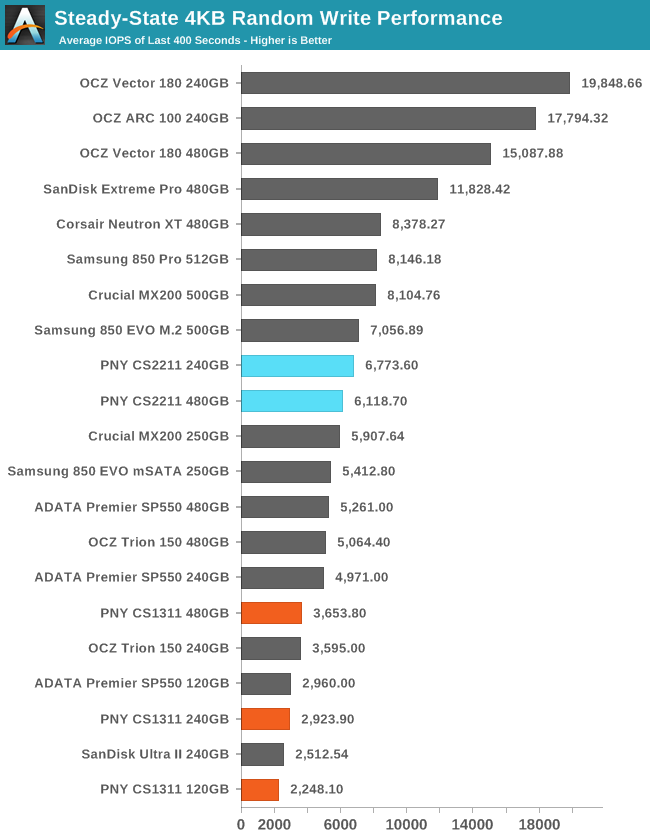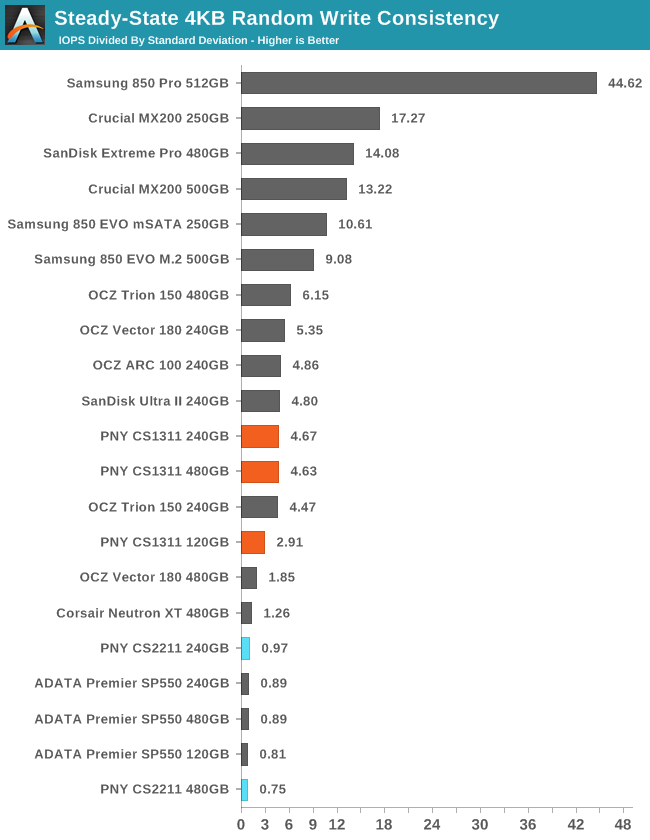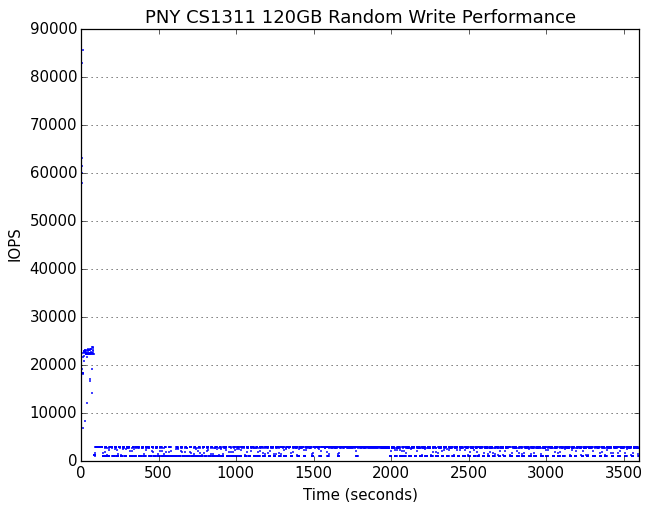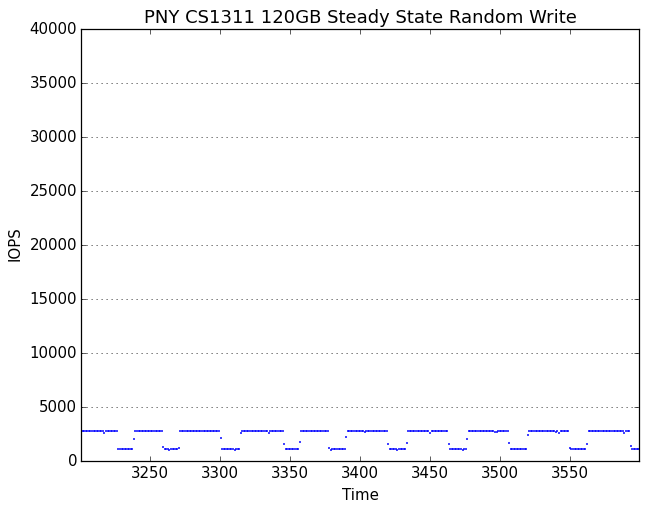The PNY CS1311 and CS2211 SSD Review: MLC vs TLC at 15nm
by Billy Tallis on April 15, 2016 8:00 AM ESTPerformance Consistency
Our performance consistency test explores the extent to which a drive can reliably sustain performance during a long-duration random write test. Specifications for consumer drives typically list peak performance numbers only attainable in ideal conditions. The performance in a worst-case scenario can be drastically different as over the course of a long test drives can run out of spare area, have to start performing garbage collection, and sometimes even reach power or thermal limits.
In addition to an overall decline in performance, a long test can show patterns in how performance varies on shorter timescales. Some drives will exhibit very little variance in performance from second to second, while others will show massive drops in performance during each garbage collection cycle but otherwise maintain good performance, and others show constantly wide variance. If a drive periodically slows to hard drive levels of performance, it may feel slow to use even if its overall average performance is very high.
To maximally stress the drive's controller and force it to perform garbage collection and wear leveling, this test conducts 4kB random writes with a queue depth of 32. The drive is filled before the start of the test, and the test duration is one hour. Any spare area will be exhausted early in the test and by the end of the hour even the largest drives with the most overprovisioning will have reached a steady state. We use the last 400 seconds of the test to score the drive both on steady-state average writes per second and on its performance divided by the standard deviation.

Among TLC drives, the ADATA SP550 and OCZ Trion 150 both soundly outperform the PNY CS1311 in sustained random writes. The PNY CS2211 performs well enough for a cheap MLC drive, but is also significantly behind the earlier Phison-based Neutron XT. The gap between the CS2211 and the CS1311 is clear, but there are other MLC and TLC drives blurring that line.

The CS1311's consistency score is decent despite the low overall random write performance. The CS2211 has a very low consistency score, indicating that there's a major difference in firmware between the two models. We would normally expect ongoing garbage collection to be easier for a MLC drive, especially one with as much spare area as a typical TLC drive.
 |
|||||||||
| Default | |||||||||
| 25% Over-Provisioning | |||||||||
The difference in behavior between the the CS1311 and CS2211 is very clear. The TLC-based CS1311 has the tight regulation of performance we saw on the OCZ Trion 150 while the MLC-based CS2211 behaves like earlier Phison-based drives by having a solid baseline with widely varying performance above that.
 |
|||||||||
| Default | |||||||||
| 25% Over-Provisioning | |||||||||
The 240GB CS1311 and 240GB Trion 150 alternate between the same two performance states, but the Trion 150 spends a far larger portion of its time in the higher performance state. At the 480GB capacity, the Trion 150's slower performance state is the CS1311's faster state.
The CS1311 responds better to overprovisioning than the CS2211, leading to the 480GB CS1311 providing a steady 10k IOPS while the CS2211 varies from 3k to 27k IOPS.










43 Comments
View All Comments
Ascaris - Friday, April 29, 2016 - link
My PNY 760 is still going strong too. No plans to replace it at present, as it still does what I need.StrangerGuy - Friday, April 15, 2016 - link
I know this is an SSD, but...PC industry: "Hey, let's continue to make gaudy looking hardware to appeal to the xtremez hardcorez teenage gamerz crowd instead of adult gamers with actual disposable income."
deeksha - Saturday, April 16, 2016 - link
yours idea is really good and innovative , these resources are really awesome thanks for sharing those information and i got more in formation about this concept.
watzupken - Saturday, April 16, 2016 - link
I have to agree that at the mid/low range, currently the Samsung 850 Evo seems like the best buy in terms of performance and endurance. Still I wonder why so many manufacturers are jumping in and piling up with budget SSDs.hlmcompany - Tuesday, April 19, 2016 - link
They want a piece of the pie. They figure that with their brand on a popular item, they will be able to reap some profit. Over the years, my best selling SSD's have been Intel and Samsung. Lately, I've been impressed with SanDisk and have included them to my lineup.hlmcompany - Monday, April 18, 2016 - link
The SanDisk X400 512GB SATA SSD at $122.00 from Amazon USA is also a good option.slowdemon21 - Thursday, April 28, 2016 - link
you guys are so two-faced, the #1 complaint of SSD is too expensive, so a new lower cost SSD appears and your answers are, i.e. "not worth it...pay a little more for better" LOL bi-polar much?Ascaris - Friday, April 29, 2016 - link
Do you know for sure it's the same people making those comments? It's not hard to imagine that one site could have readers of both types commenting.slowdemon21 - Thursday, April 28, 2016 - link
one more thing...if your looking for 3 or SSD's, the extra $$ adds up. e.g. a desktop, laptop. PS4...maybe a 2 year old laptop. Bingo! four already... [talking real world]slowdemon21 - Thursday, April 28, 2016 - link
OCZ TRION 150 BENCHED IN THE MIDDLE OF MOST OF THESE TEST, there's the Winner